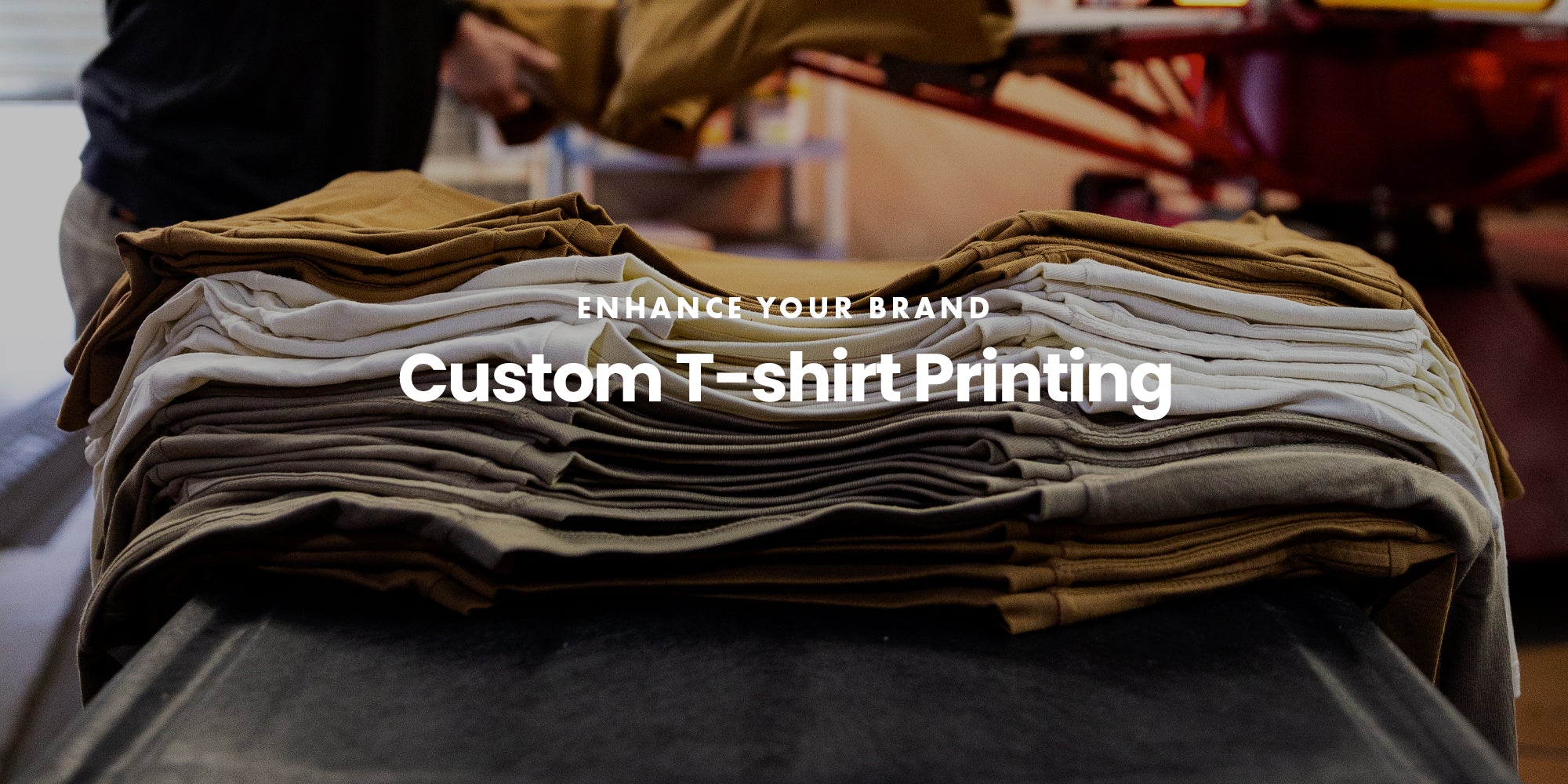Custom Screen Printing for Unique Promotional Merchandise
Wiki Article
Display Printing Uncovered: Whatever You Required to Find Out About T-Shirt and Garment Printing Methods
Screen printing is a fascinating method that integrates art with method, providing unlimited possibilities for imagination. Prepared to check out the essential elements that make screen printing an art form?
The Fundamentals of Display Printing: Exactly How It Functions
When you dive right into display printing, you'll discover it's both a scientific research and an art. At its core, display printing involves creating a pattern, or screen, that allows ink to travel through only in certain locations (screen printing kit). You begin by picking your design and preparing your screen with a light-sensitive emulsion. Once you reveal this emulsion to light, it hardens, leaving your style as an unfavorable space.Next, you'll blend your inks and prepare your printing surface area. Position the screen over the fabric, after that make use of a squeegee to push ink through the display onto the garment. This process requires precision, as you desire clear, vivid prints. After printing, you'll heal the ink with heat, ensuring it sticks to the fabric and lasts through cleans. Each action is necessary, and mastering them will boost your display printing abilities, transforming simple garments into one-of-a-kind, meaningful items.
Kinds Of Screen Printing Strategies
When you grasp the fundamentals of screen printing, it's time to discover the various strategies that can elevate your designs. One preferred technique is typical screen printing, where ink is pressed with a stenciled screen. This technique is terrific for bold, dynamic colors. There's water-based ink printing, which supplies a softer feeling and is environment-friendly, however it calls for a different method to treating.One more option is plastisol printing, understood for its resilience and vivid shades, making it a preferred for numerous brands. Experiment with halftone printing to develop gradient results and intricate designs.
Essential Devices for Display Printing
To attain sensational results in display printing, having the best devices is basic. You'll require a tough screen printing framework, which holds the mesh that moves your design onto the garment. Next, invest in high-quality mops; these are necessary for applying ink equally across the screen.Selecting the Right Inks and Products
When selecting inks and products for screen printing, you require to take into account the sort of ink that works best for your task. Think of material compatibility to ensure your designs look wonderful and last long. Additionally, explore environment-friendly ink alternatives to make your printing process extra sustainable.Kinds of Display Inks
Selecting the right screen ink is important for accomplishing lively, long lasting prints that fulfill your task's requirements. There are several kinds of screen inks to analyze. Specialty inks, such as glow-in-the-dark or metallic, can include special effects to your designs.
Material Compatibility Considerations
Comprehending fabric compatibility is essential for accomplishing high-quality screen prints, specifically given that different products react uniquely to various inks. Always check your inks on sample fabric to ensure they adhere properly and keep color honesty. Furthermore, maintain in mind that textile weight and appearance can influence the final end result, so choosing the right ink and material combination is vital for your project's success.Eco-Friendly Ink Options
Environment-friendly inks are ending up being a preferred choice for screen printers who desire to decrease their environmental effect while keeping quality. When picking inks, take into consideration water-based inks, which are much less damaging and simpler to cleanse up contrasted to standard solvents.In addition, search for inks made from renewable energies, such as soy or vegetable-based alternatives. By picking the best inks and products, you'll not only produce sensational layouts but additionally add to an extra sustainable printing procedure. Make the switch, and your prints will certainly reflect your dedication to the environment!
Preparing Your Design for Display Printing

File Format Requirements
To guarantee your layout looks sharp and dynamic on material, you'll need to pay attention to file format needs for display printing. Beginning with vector data like AI or EPS, as they can be scaled without losing high quality. If you make use of raster pictures, go with high-resolution data, such as TIFF or PNG, preferably at 300 DPI. Avoid utilizing JPEGs, as they can lose clearness when resized. Likewise, make certain your design has a transparent background to avoid undesirable white edges on your prints. Keep color modes in mind; CMYK is common for display printing, so transform your RGB makes accordingly - screen printing kit. By adhering to these guidelines, you'll set your artwork up for a successful print.Color Separation Techniques
Color splitting up is a necessary action in preparing your design for display printing, and understanding it can greatly improve your print high quality. You'll require to damage your layout into private shades, as each shade calls for a separate display during printing. This precision not only assures precise shade representation yet likewise improves the printing procedure.Resolution and Size
Accomplishing the most effective lead to display printing begins with assuring your layout has the right resolution and dimension. Ideally, your art work must go to the very least 300 DPI (dots per inch) for sharp, clear prints. If you use lower resolution, your final product could look pixelated and unprofessional.When it concerns dimension, think about the measurements of your print location. Design your art work to match the last print size, preferably creating it in the actual dimensions you'll be printing. This way, you'll prevent any unanticipated scaling concerns.
Constantly inspect your layout in both vector and raster formats. Vector graphics can be scaled without losing quality, making them optimal for screen printing. Preparing correctly will assure your layout looks amazing on every garment!
Step-by-Step Display Printing Process
Screen printing is a dynamic process that permits you to produce dynamic layouts on numerous surfaces. To get started, you'll require a screen, solution, and your picked ink.Pour ink onto the screen and utilize a squeegee to press the ink via the pattern onto the textile. Lift the display carefully and allow the print dry. You have actually efficiently display printed your layout.
Tips for Successful Screen Printing Projects
While you're diving into your display printing jobs, remember that preparation is vital to success. Start by collecting all your products-- inks, mops, garments, and displays. A clean workspace helps prevent unwanted mistakes, so clean prior to you start.Following, confirm your art work is high-resolution and properly sized for your garment. Examine your display for correct exposure and tidy it thoroughly to prevent spots. When mixing your inks, follow the manufacturer's standards to accomplish the appropriate consistency.
Throughout printing, use also stress with your squeegee for regular outcomes. Do not rush; take your time to verify each print fulfills your criteria. After printing, allow your garments completely dry entirely prior to managing or packaging them.
Lastly, always keep a sample of your help future referral. In this manner, you can examine your progress and enhance your techniques gradually. Delighted printing!

Frequently Asked Concerns
How much time Does It Require To Set up a Screen Printing Work?
Setting up a display printing job typically takes around half an hour to an hour. You'll prepare the displays, mix inks, and adjust the press. The time differs based on intricacy and experience, so remain arranged!Can I Publish on Different Material Types Making Use Of the Same Method?
Yes, you can print on various fabric types making use of the same technique, however you'll need to change your inks and settings. Some textiles take in ink in a different way, so exploring guarantees the very best outcomes for every product.What Are Common Mistakes to Avoid in Screen Printing?
When display printing, avoid usual errors like utilizing the incorrect ink, disregarding appropriate exposure times, or avoiding pre-press checks. Always evaluate your configuration and keep tidy screens to guarantee high quality results each time.Exactly How Can I Correctly Tidy and Preserve My Screen Printing Tools?
To properly clean and preserve your screen printing devices, you ought to frequently wash displays with suitable solvents, inspect mops for wear, and assure all tools are kept completely dry and dust-free. Consistency improves and protects against expensive repairs performance.Is Display Printing Eco-friendly Contrasted to Other Methods?
Screen printing can be more eco-friendly than various other approaches, particularly if you use eco-conscious products and water-based inks. By choosing sustainable materials and techniques, you decrease waste and lessen your effect on the planet.Screen Printing Uncovered: Every Little Thing You Need to Know Regarding T-Shirt and Garment Printing Strategies
At its core, screen printing includes creating a stencil, or display, that enables ink to pass via just in specific locations. Setting the screen over the textile, after that make use of a squeegee to press ink through the screen onto the garment. One preferred technique is traditional screen printing, where ink is pressed with a stenciled screen.When picking inks and products for display printing, you need to take right into account the kind of ink that works ideal for your job.
Report this wiki page